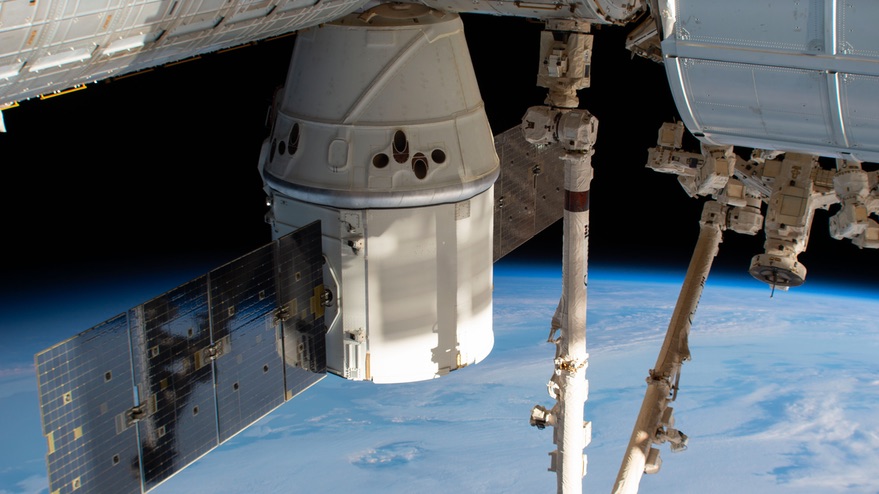NASA moves ahead with cargo Dragon launch after Crew Dragon anomaly

Updated April 24 2:30 p.m. with SpaceX statement on droneship lading.
WASHINGTON — NASA is moving ahead with plans to launch a cargo version of a SpaceX Dragon spacecraft to the International Space Station next week as the investigation into an explosion of a Crew Dragon spacecraft continues.
During a previously scheduled media teleconference April 22 about the upcoming cargo mission to the station, designated CRS-17, NASA spokesman Josh Finch said that the mission remained scheduled for launch April 30 at 4:22 a.m. Eastern. Three days earlier, NASA moved the launch from April 26, citing “station and orbital mechanics constraints.”
NASA provided no updates during the briefing about the April 20 Crew Dragon anomaly that took place while testing the SuperDraco thrusters that are part of that spacecraft’s abort system. Finch referred reporters to the statement posted on social media shortly after the accident by NASA Administrator Jim Bridenstine. SpaceX also has not provided any updates on the status of the investigation.
The incident, at SpaceX’s Landing Zone 1, produced a large cloud visible for miles and reportedly caused major damage to the Crew Dragon spacecraft, the same one that flew the Demo-1 test flight to the ISS in March and was bring prepared for an in-flight abort test this summer. That is expected to delay both that in-flight abort test and the Demo-2 crewed test flight by at least several months, depending on the cause of the accident, steps needed to remedy the problem and status of production of other Crew Dragon spacecraft.
The fact that NASA is, for now, proceeding with the cargo Dragon mission suggests the problem is isolated to the SuperDraco thrusters, which are not used on the cargo version of Dragon. However, industry sources say that the CRS-17 mission could still be delayed depending on what the ongoing investigation might turn up in the coming days, as well as any concerns raised by the station’s international partners.
SpaceX did, though, file a license application with the Federal Communications Commission April 22 for a Falcon 9 first stage landing on a droneship a short distance offshore for an upcoming launch. Falcon 9 first stages for Dragon cargo missions usually land back at Landing Zone 1, suggesting that the ongoing investigation or cleanup from the Crew Dragon incident makes the zone unavailable for the upcoming launch.
SpaceX confirmed April 24 that the company will most likely attempt to land the Falcon 9 first stage on a droneship rather than Landing Zone 1 “to ensure the integrity of the area and preserve valuable information.”
The Dragon’s cargo will feature nearly 1,700 kilograms of science payloads. They include a number of biomedical and pharmaceutical experiments, such as several “tissue chip” experiments that, in microgravity, could allow for accelerated testing of treatments for diseases. Another experiment, called the Photobioreactor, will test the ability to grow algae in space that could be used for food on future long-duration space missions.
The Dragon is also carrying the Orbiting Carbon Observatory (OCO) 3 experiment that will be mounted on the exterior of the station. The $110 million payload, which NASA sought to cancel in its fiscal year 2018 and 2019 budget requests, will measure carbon dioxide levels in the atmosphere, providing continuity should the existing OCO-2 spacecraft stop operating.
OCO-3 orbit’s on the ISS will be different from that of OCO-2, which is in a sun-synchronous orbit. “The opportunity to go to the International Space Station is actually really exciting and adds some new features,” said Annmarie Eldering, OCO-3 project scientist at the Jet Propulsion Laboratory, during the briefing, such as the ability to see the same area at different times of day to measure diurnal variations in carbon dioxide levels.
The Dragon CRS-17 mission will come on the heels of Northrop Grumman’s NG-11 Cygnus mission, which berthed with the station April 19, two days after its launch on an Antares rocket from Virginia. That spacecraft brought more than 3,400 kilograms of cargo to the station, including 1,569 kilograms of science investigations.
Related
ncG1vNJzZmiroJawprrEsKpnm5%2BifK%2Bt0ppkpqemmsBurceemJ1lp57BqXnCmqmgp12Zv6KzzqdkpZmlo7CpecCfq56qXZi%2FpsOMnaman5%2BjeqK6zqaYpbFf